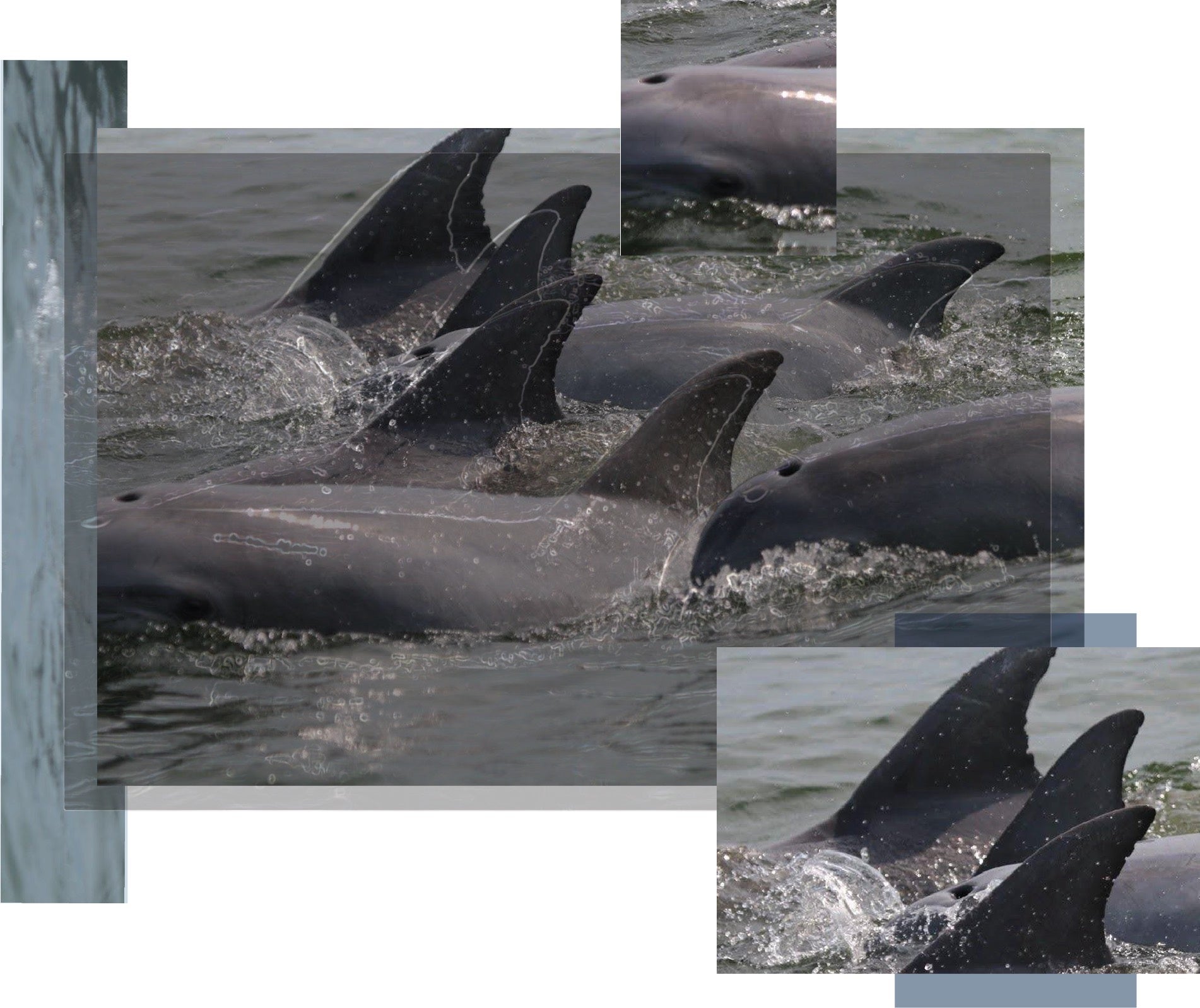Searching for Dolphins in the Potomac River
By Janet Mann, Distinguished University Professor, Departments of Biology and Psychology, Georgetown University
Research Furthered by the Earth Commons and Eco Impact Awards
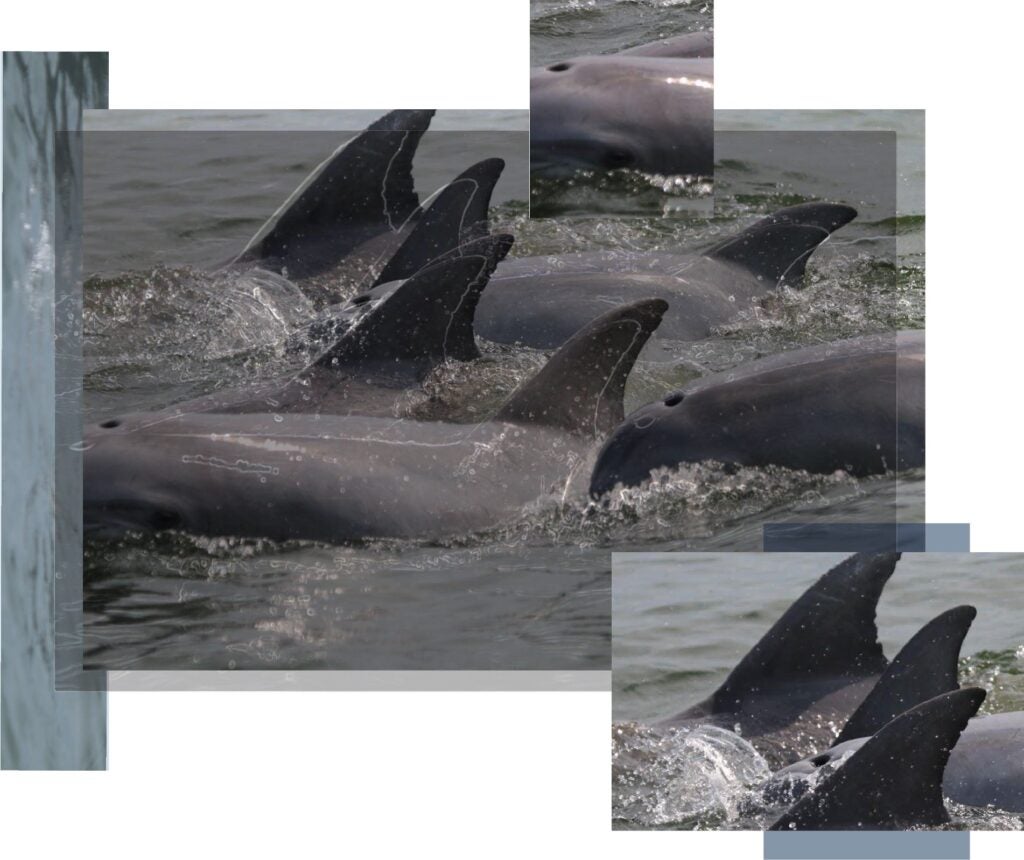
Bottlenose dolphins breathing in synchrony in the Potomac River. Note the open blowholes of three dolphins visible. Photo by Melissa Collier under NMFS permits #19403 and 23782; design by Cecilia Cassidy.
In the quiet winter months of 2012, my husband Tom started looking at homes in the Northern Neck of Virginia. His objective — not mine: to find a place where we could relax and he could get me away from my work. I am a bit of a workaholic, but as a wildlife biologist studying dolphins in Australia since the 1980s, what else would I want to be doing?
I succumbed after we found a small cedar cottage on the lower Potomac River, in the tiny community of Ophelia. The day we closed on the cottage, a warm and sparkling April afternoon, we arrived for our first overnight stay. I wandered into the backyard overlooking the Potomac River, with container ships chugging along the Chesapeake Bay in the distance. A bursting “puuhh” sound caught my attention — dolphin breaths. Really? I looked about and heard another “puuhh,” then another. As I have heard dolphins breathing for thousands of hours in Australia, there was no mistaking that sound. The distinctive dorsal fins of several bottlenose dolphins glided through the water, less than 100 yards from shore. I couldn’t believe it. I thought it was a fluke. Ha! I had no idea that there were dolphins currently in the Potomac River, but I had years before heard of reports of dolphins near Georgetown in the late 1800s.
Our new neighbor, Bob Hunter, an energetic former Navy officer well into his 80s, was always looking for someone to go boating with, and of course, I was thrilled to accompany him. That one observation of dolphins turned into a regular event over the next few years. Bob and I saw dolphins in the Great Wicomico River, dolphins in the Chesapeake Bay, dolphins in the Potomac River and dolphins in the Rappahannock River. I had been traveling exactly halfway around the world to study dolphins in Shark Bay, Australia when they had been in my backyard.
In 2013, shortly into my time sighting dolphins in the Potomac, tragedy struck for dolphins ranging from New York to Florida. An infectious respiratory virus morbillivirus (related to measles) began killing dolphins by the hundreds. When dolphins breathe together at the surface, they exchange respiratory droplets and can infect each other with the virus. The origin seemed to be in the Chesapeake Bay and Virginia waters, where the first and many more documented deaths occurred. These disease outbreaks occur about every 20 years and have been known to kill thousands of dolphins worldwide. This time around, over twenty thousand dolphins are thought to have perished from waters spanning the eastern seaboard of the U.S., particularly the mid-Atlantic region.
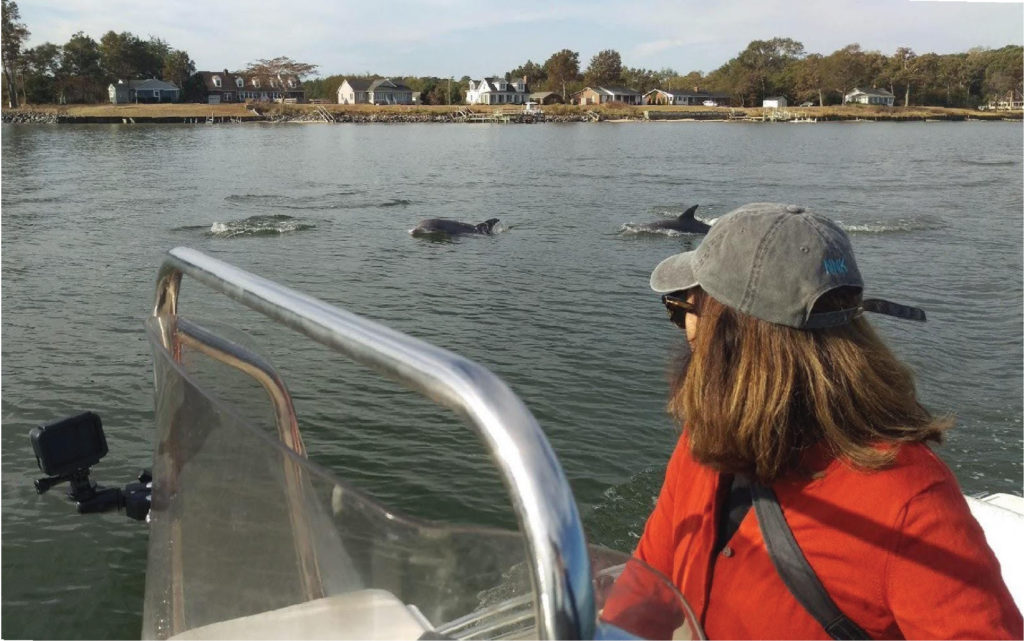
Professor Janet Mann on a survey of dolphins near her Potomac River home. Photo taken by Ann-Marie Jacoby under NMFS permits #19403 and 23782.
The epidemic was officially over by March 2015, and four months later, the Potomac-Chesapeake Dolphin Project (PCDP) was born. Our mission is to better understand and protect the bottlenose dolphins, recently classified as a new species (Tursiops erebennus), of the Potomac River and the Chesapeake Bay. Knowing more about the dolphins that come into the Chesapeake, why they are susceptible to disease, and where else these dolphins might go to spread disease, will hopefully help us better prepare for the next epidemic. To aid in this work, I recruited current and former Georgetown students and fellow Georgetown professor Dr. Shweta Bansal, a disease ecologist, to the cause.
Without The Earth Commons (called the “Georgetown Environment Initiative” in 2015), we may not have gotten this project off the ground. A joint award with the McCourt Mass Data Institute helped us launch the project, including the purchase of our small skiff, Ahoya. We have surveyed the Potomac-Chesapeake dolphins every year since, starting with 200 dolphins in the first year, and counting over 2000 individuals in 2023. We use photographs of the nicks, notches, scars, and shapes of their dorsal fins to identify individuals and match them from year to year. Given our proximity to our capital, we name them after prominent US political figures, historical leaders, and activists. We happen to see Bill Clinton, a large male that loves to bowride, every year. Fredrick Douglass is not much of a bowrider, but we see him often. Martha Washington, Megan Rapinoe and Barbara Bush are also regular visitors. Bipartisanship abounds in the Potomac waters.
Just as the number of dolphins has expanded, so have the questions — and none of this research would be possible without students. For the last 10 years, well-trained and dedicated students from Georgetown and Duke University have been tackling questions such as: Why are the dolphins coming into the Potomac River and the Chesapeake Bay? How far upriver are the dolphins traveling? What time of year do they arrive and how long do they stay? Are the same dolphins returning every year? What are the sources of mortality and morbidity in the population? How often do they have calves? How many calves survive? How big is the population and what role do they play in the Potomac River and Chesapeake Bay ecosystem? Is the population recovering from the epidemic?
The morbillivirus epidemic inspired the research of Dr. Melissa Collier, now a postdoctoral scholar at Georgetown University, who has been examining how social behavior is linked to disease transmission. Specifically, by documenting how often dolphins synchronously breathe in close proximity to each other, she has gathered data on how this respiratory disease can spread from dolphin to dolphin. With this data, Melissa has successfully modeled how disease can move through the population and differentially impact males and females, young and old. For example, adult male dolphins and juvenile dolphins (ages 4 to 10) breathe in synchrony with each other more often than adult females and calves. Interestingly, adult males and juveniles died in disproportionately higher numbers during the epidemic — a finding that their social behaviors could explain.
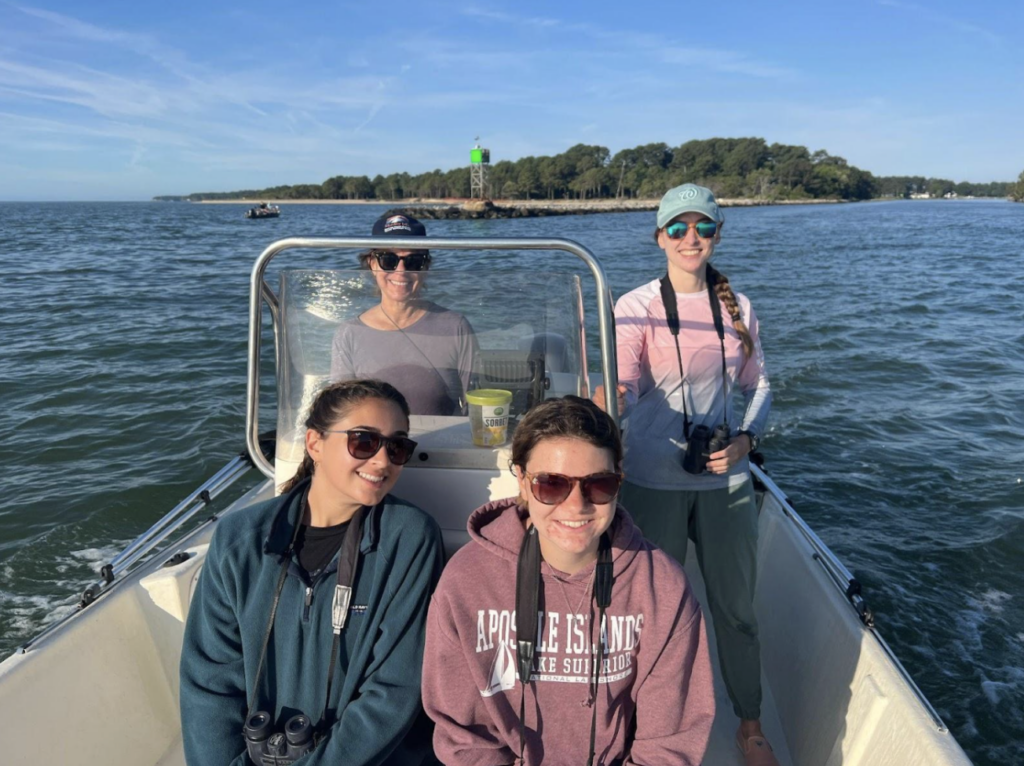
Clockwise, Professor Janet Mann, Verena Conkin, and undergraduate students Abby Mueller and Karina Long embark on a day of surveys. Photo taken under NMFS permits #19403 and 23782.
In 2023, we received an ECo Impact award to quantify seasonal dolphin abundance in the lower Potomac River and identify spatial and temporal trends in habitat use. Verena Conkin, a NSF Graduate Research Fellow in her second year, is conducting surveys along new transects designed to provide robust population estimates and deploying a drone from the boat to take high-resolution images of dolphins to estimate body lengths. Drones will help us assess dolphin body condition and size so we can model the demographic composition of the population as that will tell us whether they are growing, stable, or in decline. Critically, this work will aid federal and state efforts to manage marine mammal stocks as mandated by the federal Marine Mammal Protection Act (1972). The ECo Impact award will allow us to demonstrate proof of concept, using state-of-the-art mark-recapture techniques to develop a population model, and novel use of drone technology; the award will also establish a new collaboration with National Marine Fisheries Service (NMFS) personnel.
Even NMFS scientists (based in Silver Spring, Maryland) are surprised to hear that there are so many dolphins in the Potomac River. Like most DC residents, the Potomac’s image is largely based on the upper Potomac flowing under the Memorial Bridges by the National Mall. The lower Potomac bears little resemblance to the bustling waterfront at Georgetown, save the presence of gulls and cormorants. In the lower Potomac, homes and farms dot the shoreline and wildlife is abundant with pelicans, egrets, herons, bald eagles, osprey, the occasional sea turtle and heaps of stingrays, fish and sea nettles. There are a few stray water bottles and debris, but we commonly retrieve balloons and other trash dangerous to marine life.
At sunrise, we depart from Smith Point Marina after loading our gear into Ahoya. We leave the Little Wicomico River and drive to the start of our first transect, an area that we survey in the Potomac River every month. Each observer is positioned to look for dolphins from a different part of the boat. We head upriver, searching for dolphins. We spot a group of dolphins and slowly approach them to record their location, behavior, and ages (based on size). We try to photograph every animal and determine which calf belongs to which mother, and we assess and monitor their health. Some of the dolphins have lesions and appear thin. A calf born here in 2019 will still be nursing in 2020 and 2021, but if we see the mother and no calf, then it is unlikely that the calf survived. About 20% of the dolphins we have sighted in one year are seen in another year, enabling us to document survival for many of the newborns in the Bay. Rachel Revere (named after the wife of Paul Revere) has been seen every year of the study with two different calves.
Undergraduate students have also been very involved with the research both in the field and in the lab. Milan Dolezal (C’21) led a study examining stem barnacles that attach to dolphins and other cetaceans worldwide. This work was published in Marine Mammal Science last year. Another undergraduate is developing AI methods for examining lesion presence and the prevalence of tooth rakes (aggression received from other dolphins). Several other undergraduate-led research projects are underway.
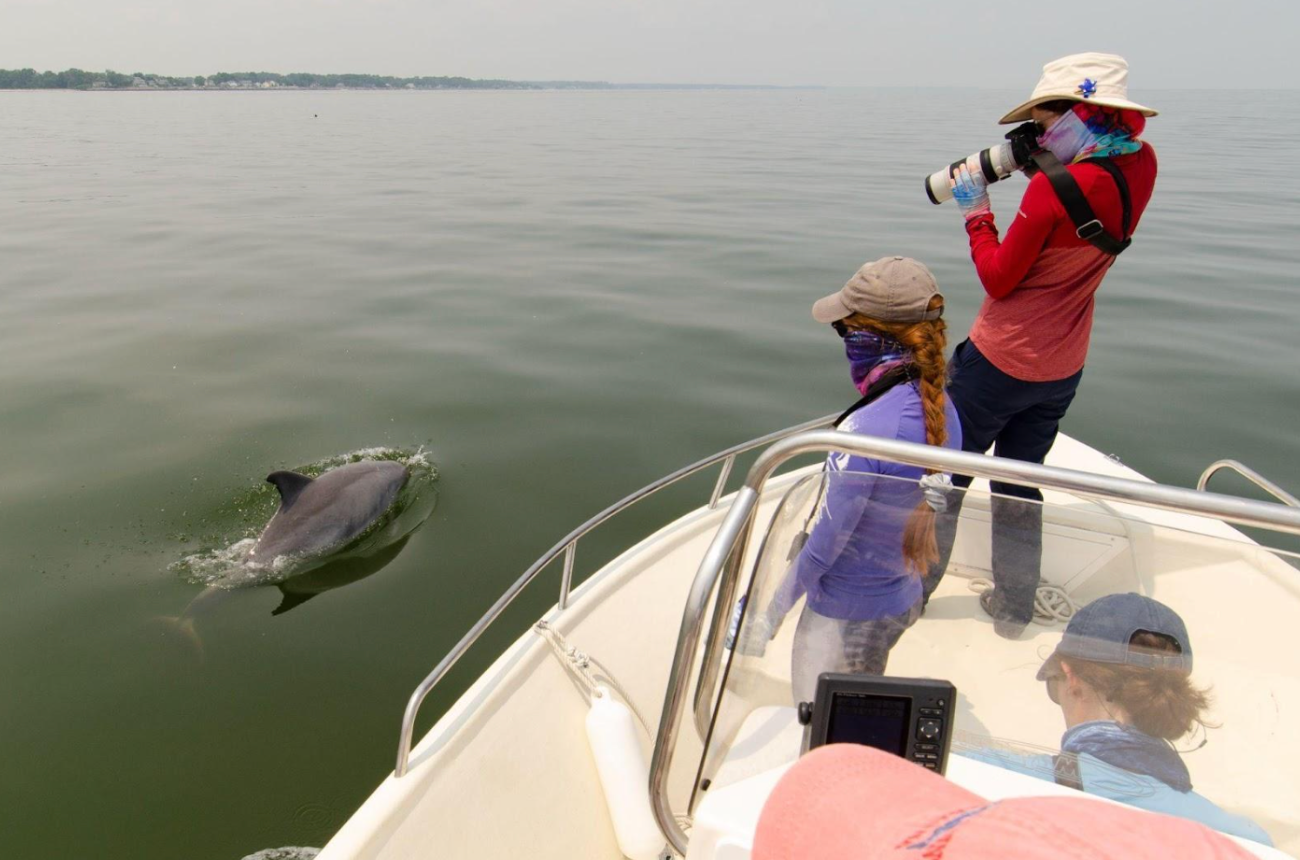
Dr. Melissa Collier and Ellen Jacobs conducting a survey and photo ID of dolphins. Photo taken under NMFS permits #19403 and 23782.
To get a different perspective on what the dolphins are doing underwater and expand our study area, we deployed six hydrophones halfway up the tidal Potomac so we could document dolphin presence through sound. If you have ever heard a creaking door, that is kind of what dolphin echolocation clicks, or sonar, sounds like. Dolphins have an exquisite skill — echolocation — which helps them locate and catch fish in these murky waters by listening to the echoes of their clicks to sense where their prey are moving. Ellen Jacobs, another Georgetown University PhD candidate, is examining the way that dolphins use the river as a foraging area by monitoring their echolocation behavior.
My surprise at first seeing dolphins in the Potomac is shared among many who hear of dolphins being in the area. I am frequently asked if dolphin presence in the area is a new phenomenon and if sightings are increasing. Since we only started this research in 2015, we cannot answer that question with our observations of dolphins. Ann-Marie Jacoby, who worked with me as an undergraduate at Georgetown and is now a Duke University Ph.D. candidate and Associate Director of the PCDP, is trying to answer this question by interviewing those with a great wealth of knowledge about the Potomac River, fishers (colloquially known as watermen and women). Ann-Marie is going even further back in time by searching through historic archives for newspapers published in counties along the Potomac from the 1700s to the present day. We will soon know when dolphins stopped visiting the shores of Georgetown.
So, in the end, my husband did not get his wish; he did not manage to get me away from my work. But we have made many friends in the Northern Neck, as the research and people have connected me to the area and enthralled me with its feral beauty and dedicated community. I have many to thank for this work: Bob Hunter, my husband, the wonderful students and colleagues who have enriched the research, and of course, the Earth Commons, which is helping us answer vital questions necessary to meet our mission to protect and conserve the bottlenose dolphins of the Potomac River and Chesapeake Bay through research.
To learn more, visit our website www.pcdolphinproject.org and follow us on Facebook, Instagram, and Twitter (X) via @pcdolphinproj

